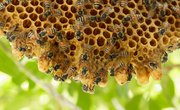
So, you were out hiking and you came across a wild honey bee hive, also known as a bee nest. Now you're wondering how you can extract the bee's honey from that honeycomb, right? Humans (and other animals) have been using honey for culinary treats, medicine and sustenance for hundreds of years.
While nowadays it's much more common to get honey from professional beekeepers who manage lots of hives, you can still do things the old fashioned way by extracting honey from a wild bee hive yourself.
How to Identify a Wild Comb
Wild honey bee nests are often found in hidden places that offer the bees protection. Ground bees can make hives in between rock crevices and even in holes in the ground. Tree bees commonly make their hives at the end of branches and inside hollow trees.
The honeycomb itself is made by the worker bees. They chew the beeswax and create large honeycombs of hexagonal shape. It's within these cells of the honeycomb that the honey is found. You can see a picture of what a wild honey bee nest looks like inside of a tree here.
Some Words of Caution
If you find a wild bee hive, your first instinct might be to harvest the honeycomb for honey. There are a few things you should consider first though.
The first thing is that bees are capable of stinging you. And if you threaten their hive, many bees may rush at you and sting you. Depending on the bees you're dealing with, this could result in a serious medical emergency, especially if you're allergic or sensitive to bee stings.
The second thing to keep in mind is that you often have to destroy the entire hive in order to extract honey from the honeycomb. This means destroying a colony of bees, disrupting their home and potentially causing the death of that population of bees.
Another thing to keep in mind is that not all hives have honey in it. You need to make sure you've found a honey bee hive before you attempt to get it and extract honey. Wasps and Yellowjackets make hives as well, but there's no honey to be found within their hives. If you're going to extract the honey, try and choose a hive that has few or no bees left within it in order to avoid harming the bees and their home.
Extracting Bee Hive Wild Honey: Step One
First you need to drive the bees out of the hive. You can do this by creating a small smoky fire and holding or making it near the entrance holes of the hive. This will both calm the bees and drive many of them away from the hive.
Step Two
Next, you'll need to break the hive open. Depending on the size of the hive, you can use a knife or a saw. Be sure to make the opening large enough so that you can fit your hand inside to create an opening big enough to put your hand in the hive.
Step Three
Once you can reach into the hive, remove the honeycomb itself by simply breaking it off of the hive. If you find that breaking it with your hand is tough, you can reach in with the knife you used to create the opening and cut the comb instead.
Step Four
Now that you have the honeycomb, you can begin to separate the brood cells from the cells that actually contain honey. You can identify the brood cells by looking at the coloration. Brood cells are much darker than the honey cells and they're often found at the bottom of the honeycomb. Use your knife to cut away the darker brood cells and discard.
Step Five
Now that you have the honeycomb properly separated, break up the remaining honeycomb into a colander or a strainer. Place that on top of a bowl. The bowl is what's going to catch the honey.
Take a spoon or a masher and mash/press the honeycomb. This will release the honey from the comb and it will drain through the strainer into the bowl below leaving the wax behind in the strainer.
Step Six
Take the bowl that contains the extracted honey and run it through a strainer again. This will separate out any remaining chunks of wax. Lastly, put this strained honey in a jar or bottle for use and/or storage. All that's left to do is enjoy!
Tips
If you do this step five with the bowl/strainer over warm water, it can speed up the process since it helps the honey move easier through the strainer.
References
About the Author
Elliot Walsh holds a B.S in Cell and Developmental Biology and a B.A in English Literature from the University of Rochester. He's worked in multiple academic research labs, at a pharmaceutical company, as a TA for chemistry, and as a tutor in STEM subjects. He's currently working full-time as a content writer and editor.
Photo Credits
bee bees apises beehive hive insect image by Pali A from Fotolia.com
